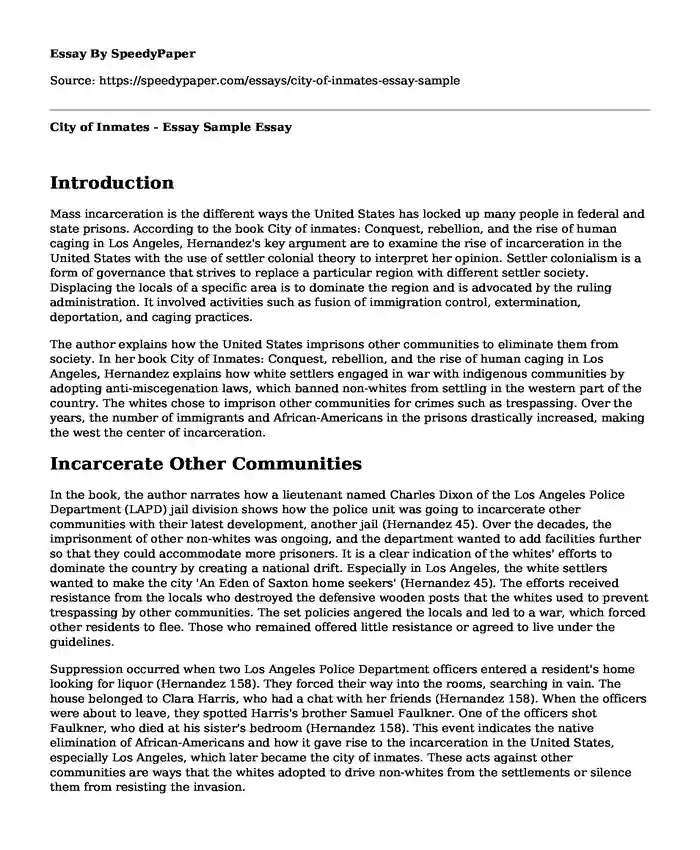
| Type of paper: | Essay |
| Categories: | United States Literature Penal system |
| Pages: | 3 |
| Wordcount: | 625 words |
Introduction
Mass incarceration is the different ways the United States has locked up many people in federal and state prisons. According to the book City of inmates: Conquest, rebellion, and the rise of human caging in Los Angeles, Hernandez's key argument are to examine the rise of incarceration in the United States with the use of settler colonial theory to interpret her opinion. Settler colonialism is a form of governance that strives to replace a particular region with different settler society. Displacing the locals of a specific area is to dominate the region and is advocated by the ruling administration. It involved activities such as fusion of immigration control, extermination, deportation, and caging practices.
The author explains how the United States imprisons other communities to eliminate them from society. In her book City of Inmates: Conquest, rebellion, and the rise of human caging in Los Angeles, Hernandez explains how white settlers engaged in war with indigenous communities by adopting anti-miscegenation laws, which banned non-whites from settling in the western part of the country. The whites chose to imprison other communities for crimes such as trespassing. Over the years, the number of immigrants and African-Americans in the prisons drastically increased, making the west the center of incarceration.
Incarcerate Other Communities
In the book, the author narrates how a lieutenant named Charles Dixon of the Los Angeles Police Department (LAPD) jail division shows how the police unit was going to incarcerate other communities with their latest development, another jail (Hernandez 45). Over the decades, the imprisonment of other non-whites was ongoing, and the department wanted to add facilities further so that they could accommodate more prisoners. It is a clear indication of the whites' efforts to dominate the country by creating a national drift. Especially in Los Angeles, the white settlers wanted to make the city 'An Eden of Saxton home seekers' (Hernandez 45). The efforts received resistance from the locals who destroyed the defensive wooden posts that the whites used to prevent trespassing by other communities. The set policies angered the locals and led to a war, which forced other residents to flee. Those who remained offered little resistance or agreed to live under the guidelines.
Suppression occurred when two Los Angeles Police Department officers entered a resident's home looking for liquor (Hernandez 158). They forced their way into the rooms, searching in vain. The house belonged to Clara Harris, who had a chat with her friends (Hernandez 158). When the officers were about to leave, they spotted Harris's brother Samuel Faulkner. One of the officers shot Faulkner, who died at his sister's bedroom (Hernandez 158). This event indicates the native elimination of African-Americans and how it gave rise to the incarceration in the United States, especially Los Angeles, which later became the city of inmates. These acts against other communities are ways that the whites adopted to drive non-whites from the settlements or silence them from resisting the invasion.
Conclusion
Additionally, the book also notes the Mexicans' reflection who live in the United States and the experiences they go through. Pedro Gonzalez and his band came up with a song, which the Mexicans who lived in the United States were eager to listen in the morning (Hernandez 131). The radio aired in Los Angeles and narrated Mexican life's rhythms in the United States (Hernandez 131). The songs chronicled the persistent tales of labor, disappointment, and fear of lining in America (Hernandez 131). The songs provided a real picture of the trouble that other communities had to endure while living in the United States. It helped to expose the vast structural inequities that happened back then.
Work Cited
Hernández, Kelly Lytle. City of inmates: Conquest, rebellion, and the rise of human caging in Los Angeles, 1771–1965. UNC Press Books, 2017.
https://www.jstor.org/stable/10.5149/9781469631196_hernandez.
Cite this page
City of Inmates - Essay Sample. (2023, Dec 25). Retrieved from https://speedypaper.net/essays/city-of-inmates-essay-sample
Request Removal
If you are the original author of this essay and no longer wish to have it published on the SpeedyPaper website, please click below to request its removal:
- Free Essay on Individual Style of Writing
- Research Essay Outline Example: Emancipation
- Free Essay Example about Rabbi Modena
- Texas Is a Small-Government State - Free Essay Sample
- Antitrust Case Analysis
- Independence Declaration: US Declaration of Freedom from Britain, 1776 - Paper Example
- Paper Sample on China's Treasure Fleet
Popular categories




